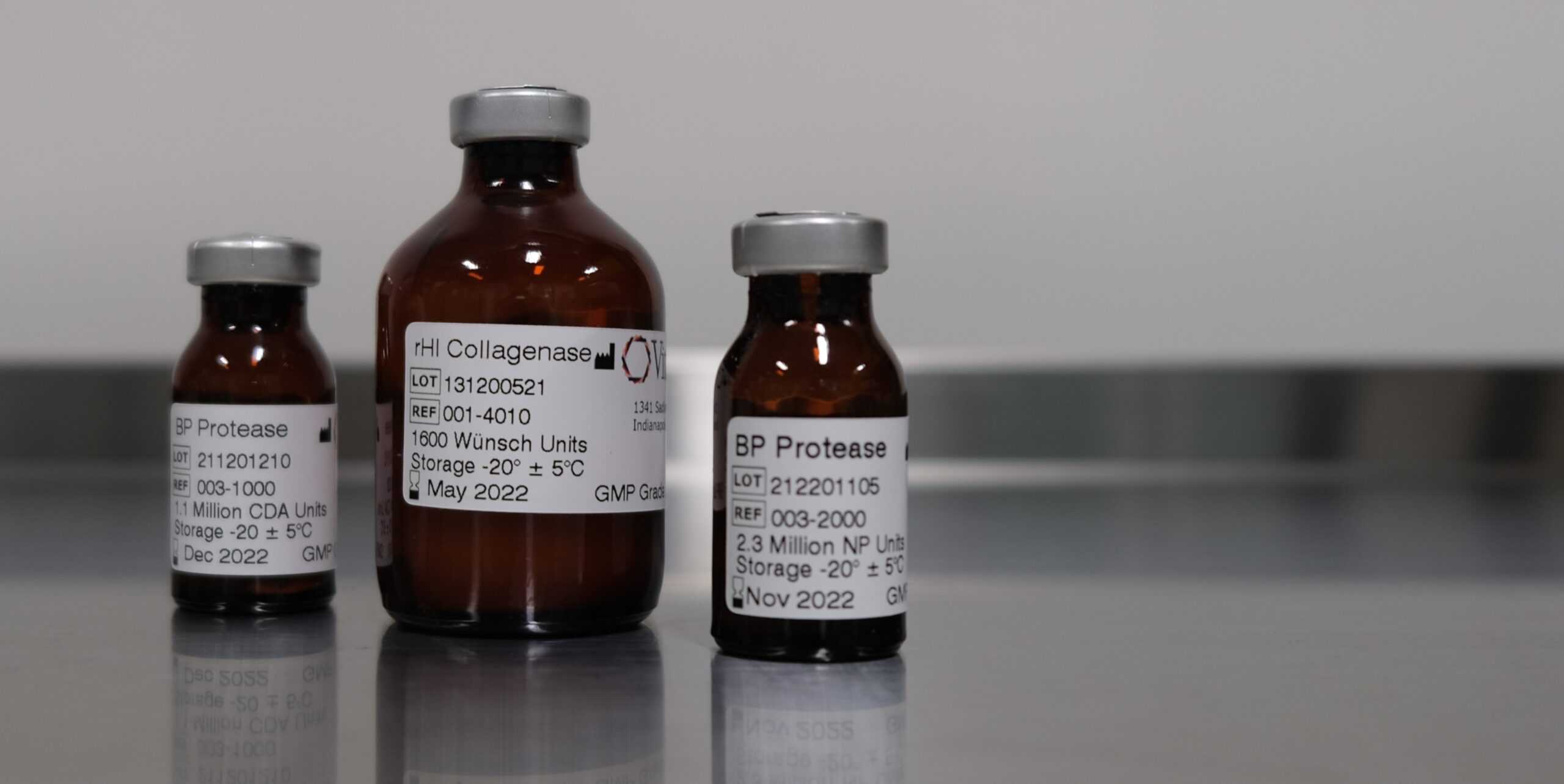
In 1975, Godo Shusei manufactured a purified bacterial protease from Bacillus polymyxa (now reclassified and renamed as Paneibacillus polymyxa), trademarked Dispase™, to use in place of bovine or porcine trypsin for harvesting cells from culture.(1) Dispase is an animal-origin-free (AOF – no animal components used in fermentation or during purification process) protease less aggressive than trypsin. Although this enzyme never met Godo’s expectations to replace trypsin, it has its own niche in isolating cells from tissue or recovering and passaging cells in cell culture.
For many years, Godo Sushei was the primary supplier of this Dispase. Dispase was distributed through other biochemical suppliers who sold the trademarked product under their labels. In 2010, VitaCyte began selling BP Protease, a Dispase equivalent enzyme derived from a different P. polymyxa clone than used to manufacture Dispase. However, gene sequencing studies have shown minor variations in amino acid sequences between the Dispase equivalent enzymes from different P. polymyxa strains.
In 2017, VitaCyte manufactured the first and only GMP Grade Dispase equivalent enzyme, BP Protease. A comparison of Dispase manufactured by three different suppliers is presented in the table below.
| PARAMETER | GODO SHUSEIa | WORTHINGTON | VITACYTE |
|---|---|---|---|
| Product Name | Dispase® I | Dispase® I | BP Protease |
| Estimated Purity | > 95% | > 95% | > 95% |
| Animal Origin Free | Yes | Yes | Yes |
| Specific Activity U/mgb | 80,000 | 80,000 | 135,000 |
| Retention Time (min) Anion Exchange Peakb | 17 | 17 | 7 |
| Endotoxin EU/A280 | Not Reported | Not Reported | < 50 EU |
| Lower Priced Products @ » 10% Purity | Dispase® II | Dispase® II | None |
| Labeled as GMP Grade Reagent | No | No | Yes |
aGodo Shusei sells the Dispase enzyme through other suppliers under the suppliers’ label. In some cases, these suppliers will refer to Japanese equivalent enzyme U
b For more detail, see the poster presented at the World Stem Cell Summit in 2014: vitacyte.wpengine.com/app/uploads/2021/04/2014-Poster-WCSC14-BP-Protease.pdf
The products’ different specific activities likely reflect the enzyme’s autocatalysis during the manufacturing process. It has been known for many years that neutral proteases from bacilli are auto-catalytic, meaning that under the right conditions, there is inter-molecular degradation of Dispase equivalent enzymes by its proteolytic activity.(2) VitaCyte has minimized autocatalysis leading to higher specific neutral protease activities than found with other Dispase enzymes.
Dispase has been used as a research enzyme since the 1970s.(1, 3) Howard Green, whose efforts ultimately led to manufacturing cultured skin substitute products for wound care or treating burn patients, summarized the importance of Dispase for culturing keratinocytes and treating chemical burns to the eye.(4) A proximity search in Google Scholar that used the search terms “Dispase AROUND(10) cell” gave 16,300 hits for papers published in 2019 or later (performed 7 June 2023). These applications include cell isolation alone or in combination with other enzymes (e.g., collagenase); passaging of cell lines, iPSCs, or organoids grown in vitro; preparation of biomaterials such as amniotic membranes; and in vivo use as an alternative to surgery to eye conditions: treat posterior vitreous detachment or chemical burns to the eye. To find papers that used Dispase, use the same search string, but specify a specific cell or type of cells in place of cells.
One common misconception of Dispase equivalent enzymes is that protease activity is unaffected by serum. Internal studies at VitaCyte showed this is an erroneous assumption since BP Protease activity is completely inhibited when incubated with 0.5 % human serum. BP Protease, like all other endoproteases, is likely inhibited by the alpha-2-macroglobulin present in serum.(5) This misconception likely arose from an early paper using Dispase in cell cultures that stated that Dispase’s ability to recover cells from culture was minimally affected in media containing fetal bovine serum.(1) There are two possible explanations for this observation. First, alpha-2-macroglobulin is at low concentrations in fetal serum and ineffectively inhibits protease activity, or low amounts of Dispase activity are adequate for this application. Further analysis of the latter explanation at VitaCyte indicated that the Dispase concentration is about 50 µg/mL in a 1 mg/mL solution of Dispase II stored at 4ºC. VitaCyte assessed the stability of purified BP Protease enzyme activity at 1 mg/mL and showed a loss of about 60% of the protease activity after 9-14 days of storage at 4ºC. Incorporating these results with the supplier’s recommendation that a 1 mg/mL solution of Dispase II can be stored at 4ºC for up to 14 days, then only 30 µg/mL of a purified Dispase equivalent enzyme is required for use in this application. VitaCyte found that when BP Protease is combined with a AOF peptide excipient and diluted to 25 µg/mL, there was no loss of protease activity after 14 days at 4ºC.
For any technical questions, Contact Us.
References
1. Matsumura T, Nitta K, Yoshikawa M, Takaoka T, Katsuta H. Action of bacterial neutral protease on the dispersion of mammalian cells in tissue culture. Jpn J Exp Med. 1975;45:383-92.
2. van den Burg B, Eijsink VG, Stulp BK, Venema G. Identification of autodigestion target sites in Bacillus subtilis neutral proteinase. Biochem J. 1990;272:93-7.
3. Stenn KS, Link R, Moellmann G, Madri J, Kuklinska E. Dispase, a neutral protease from Bacillus polymyxa, is a powerful fibronectinase and type IV collagenase. J Invest Dermatol. 1989;93:287-90.
4. Green H. The birth of therapy with cultured cells. Bioessays. 2008;30:897-903.
5. Vandooren J, Itoh Y. Alpha-2-macroglobulin in inflammation, immunity, and infections. Frontiers Immunology. 2021;12. https://www.frontiersin.org/articles/10.3389/fimmu.2021.803244/full.
